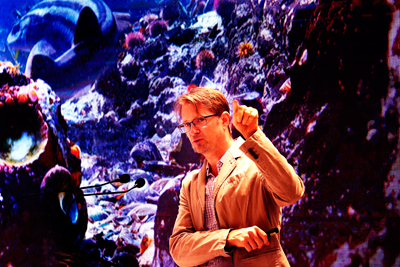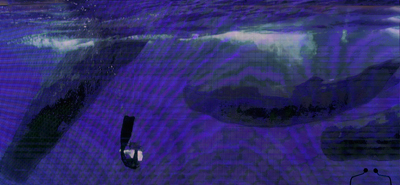Into the deep unknown with Blue Planet II

Blue Planet II Series Producer Mark Brownlow on the wonders of the ocean. Pix by M.A. Pushpa Kumara
Dropped down into the deepest darkest depths of the ocean seeing not only the wonders but also the monsters replete there, with a ‘tiny’ glimpse of Sri Lanka’s seas with the unique super-pods of sperm whales also thrown in!
We are not in a submarine diving to the ocean-bed but transported to new and exciting worlds during ‘An Evening with Mark Brownlow of Blue Planet II’ in a showroom down Flower Road in Colombo 7. This is the first time that the British Broadcasting Corporation (BBC) has permitted an in-depth behind-the-scenes look at the making of this series, we learn.
Blue Planet II, a sequel to the 2001 Blue Planet, is a wildlife documentary series presented and narrated by Sir David Attenborough exploring the oceans, of which Mark is the Series Producer. It premiered in the autumn of 2017 (last year).
This natural history film-maker, who has been part of the BBC for 20 years, is currently on a two-week tour of Sri Lanka including National Parks such as Wilpattu and Kaudulla, along with wife Sarah and daughters three, Sophie, Aimee and Grace.
This “most watched” British television series in the United Kingdom (UK) has a huge global viewership. Consisting of seven episodes, Blue Planet II had taken all of 3½ years to make.
“We launched 125 filming expeditions in 39 countries with 6,000 hours underwater, working with global experts,” says Mark. The “we” included an “eclectic” team of marine biologists, filmmakers, logistic experts and more who underwent deep-sea training including spending time in hyperbaric chambers, before embarking on voyages to beam mesmerizing footage of strange landscapes and creatures to living rooms across the world – 20 million in the UK and 200 million in China alone.
And then we, the audience in Colombo, take a deep breath to see scenes “celebrating the wonders and complexities of the deep oceans” with brief trailers to whet our appetites. “Forget outer space,” urges Mark, adding “go to the ocean depths and find new worlds”.
Into view comes a ‘sea monster’ but considered the gentle giants of the Arctic, a mother-walrus and her pup, as he explains her challenges: It’s very tough for walrus mums to raise their pups. They need the glaciers, a safe place to keep their young and rest on the ice floes, but with global warming they are facing hard times.
Next on the screen are “mind-blowing” methane volcanoes with their giant eruptions of bubbles blown from the seabed in the Gulf of Mexico, never seen or filmed prior to Blue Planet II’s explorations, after which he waxes eloquent on how intelligent marine creatures are, focusing on a common octopus living in shark-infested waters off Africa which has adapted to its dangerous environment by adorning itself with shells to protect it from turning into prey in aggressive shark attacks.
Some creatures of the sea are curious, some shy, some aggressive, laughs Mark.
Tool use, usually associated with primates to show how clever they are, has also been witnessed in fish and Mark opens up the world of the tusk fish and its modus operandi, how it picks up a clam, carries it in its mouth back to its castle and whacks it back and forth, to crack the shell and get access to a meal.
Bleaching of corals in the Great Barrier Reef and more coral reefs, all have been captured and Mark gives us a closer look at advanced technology including split screens, equipment half in water and half out, heavy loads which “killed your back to carry” which were used in the filming.
Filming in the dead of night deep down, they used state-of-the-art camera sensors which helped in extremely low light, surrounded by absolute darkness, creating an “intimate” experience.
To their aid also came advanced diving technology which allowed the divers to sit on a coral reef under water for five hours without releasing bubbles and alarming the subjects they were filming. “Unique, not possible in those days,” says Mark, pointing out how 17 expeditions to the deeps of the Antarctic were the “most” challenging, making the Blue Planet II team the first in history to do so.
“Ten hours in a submersible can drive you slightly mad,” he says, adding that “knowing that if we miss an opportunity we’ll never see that animal or landscape again” made it an equally daunting responsibility.
Taking technology to incredible places, as deep as 900 metres down, he talks not only of spectacular vistas never seen before but also claustrophobia in the bubble and asks the simple question: How do you pee, to much laughter among the audience.
No one knew what to expect as they descended 500m, 600m, 700m and then 750m in the Atlantic Ocean and saw a whale carcass, with sixgill sharks vying with each other to get a bite of it. “Then they spotted us, coming at us……pushing us. The sub is very strong but….,” he says, as we hold our breath in anticipation. Fortunately, the sharks realized that the sub was not after their meal and they returned to their food.
‘An Evening with Mark Brownlow’ was facilitated by Cinnamon Hotels and Resorts, HSBC Premier and Land Rover at its showroom down Flower Road.
| Enter Lankan whales | |
 Sri Lanka’s B. Dayaratne among the whales off Trincomalee Three years ago, Cinnamon Nature Trails Head Chitral Jayatilake and Manager Vimukthi Weeratunga who is a wildlife biologist had walked into the BBC’s office in Bristol with a video clip. A young producer who watched it had been taken by surprise and rushed off “to drag down Mark”. It was thereafter that the “conversation” that Blue Planet II should come to Sri Lanka to get footage of the super pods of sperm whales began. When they did arrive they had asked Cinnamon Nature Trails naturalist B. Dayaratne whether he could dive under water, swim beneath the whales and come up on the other side off Trincomalee to which he had readily agreed. It was when Daya did just that, the Blue Planet II team had decided to include him in the clip relating to Sri Lanka on Blue Planet II. Daya had stumbled on the super pods about three years before that following tales told by fishermen of these mystical creatures. Having filmed sperm whales across the world, Mark gives us a ringside view of a sperm-whale family resting between bouts of feeding in the West Indies. The mother-whale, refreshed after her sleep, gives her calf which is about two weeks old a milk-feed and makes ready to dive with her family in search of food, by heavy breathing which brings about saturation of her blood with oxygen. Off they go, for it is dive time for squid, with the mother and calf in constant communication through a pattern of clicks. At about 300 metres, the calf finds it difficult to keep up with the family as it cannot hold its breath. That’s when the calf is forced to sit out the hunt, while the adults continue to dive down. A series of loud and rapid clicks – sonar is used to hunt shoals of squid. At 800m, a burst of clicks from the mother and then silence, for she has made a catch. The calf, meanwhile, has a long wait. The mother returns about an hour later and it is only then that the hungry calf has its milk, the richest produced by any mammal. The calf would take about six years to master the art of deep-sea diving.
|
| In the company of Sir David Attenborough | |
| Long hours Mark spent with famous broadcaster, writer and naturalist well-known for his innovative educational television programmes, Sir David Frederick Attenborough, 92, while filming Blue Planet II. He describes Sir David as a “national treasure” who is passionate about getting the conservation message across. With plastic being one of the environmental issues, Mark asks: Do you know that a wandering albatross chick can get killed by a single toothpick, which can puncture its stomach lining. Meanwhile, a newly-discovered species of plankton, Syracosphaera azureaplaneta has been named after the BBC’s Blue Planet series in April by scientists at the University College London (UCL). This is believed to be the first time that a species has been named after a television programme. |


